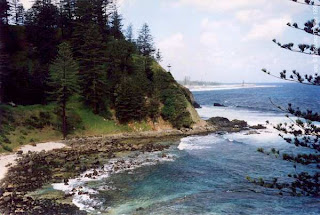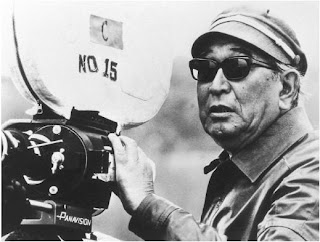Norfolk Island

Norfolk Island Coat of Arms image courtsey: wikipedia.org
Norfolk Island –This Paradise That Was Once A Hell.
Isolation has its merits.

Norfolk Island Coat of Arms image courtsey: wikipedia.org
Norfolk is a small island (about 5 – 8 Miles in diameter) in the Pacific Ocean located between Australia and New Zealand; very-very isolated as its nearest neighbor the New Caledonia is about 800 kilometers away. The land is very fertile and the climate temperate without drastic seasonal variations. For 56 long years this paradise played the role of virtual hell as it was used to inhabit hard core criminals from throughout the British Empire, the geographical isolation of this island was ideal for this purpose.
Ghost who walks!

Norfolk island image courtsey: anbg.gov.au
The natives living here are still in the clutches of those shocking memories of the past and in the eerie Norfolkian nights many still see phantom prisoner walking in chains, hear him playing violin or just moaning loudly in unbearable pain. Cellular jail of the Andaman Island and the much touted prison island of Guantanamo fades to nothing before the torture methods adopted by the jailors of this island in those dark days. The legend of “Barney Duffy” cannot be missed when Norfolk is mentioned.
Duffy an icon.
Barney Duffy was brought here as a prisoner, the six feet seven inches giant with strength of a beast and a fiercely independent mind, Duffy did not find it hard to jump the jail but leaving the island was not easy; he chose to hide in the forest for seven long years. All these seven years; he spent day time in the hollow of a large pine tree. At last he was spotted by two guards and was taken to jail at gun-point. On the way staring at the guards he uttered this curse which gained the status of a legend. Please read the following.
A curse that prevailed.
“Take me back ye lily-livered lice, but mind... before my corpse has hung a week on the Kingston gallows, ye’ll be dead..........the pair of ye!”. Duffy was hanged next day morning and two days after- it is said that- the dead bodies of these guards were found floating in the sea some where near the pine tree where Duffy hid himself for seven years. Mothers of Norfolk tell the Duffy story to their sons to make them bold and fill their mind with inspiration, thus raising Duffy to the status of an icon!
Its time would not have come.
As per the geologists Norfolk was part of the ancient continent by name Zealandia that once existed and in the course of time got submerged in the sea about 50,000 years ago. By some unknown geological reasons when Zealandia submerged in to the sea leaving only mountain peaks afloat. Perhaps Norfolk might have been a mountain peak on Zealandia or it would not have lived its destined life-span and god almighty simply let it remain to complete its mission!
Vanished in the thin air!

Norfolk Island location image courtsey: countryreports.org
The other strange thing about this land is that it has been uninhabited for most part of the time, several tribes which inhabited on it vanished in the thin air leaving some marks (like Polynesian rats, banana plants, some stone-tools etc) for the world to understand that there were people who lived there once, to where they vanished is not known to the historians, people of Norfolk are sure their island is haunted and all the early settlers would have fell victim to the ghosts who rule the Norfolkian nights.
History is born!
For Norfolk history only starts from 1774 when Captain James Cook landed (in his ship HMS Resolution) on this island. He was rather perplexed to see such a fertile land utterly uninhabited, Mr. Cook named it “Norfolk” after the Duchess of Norfolk (wife of Edward Howard Duke of Norfolk). Mr. Cook on his return took some pine samples to Britain as it was expected to yield the much needed latex for coating sea going wooden vessels.
Master artists!

Norfolk island coast image courtsey: pitcaimers.org
People from outside were brought in to sap the pine trees, as the venture was not viable and was abandoned. The geographical isolation proved ideal for a jail and criminals were brought in to be abandoned. This attempt also did not work out. But the governor of New South Wales, Mr. Thomas Brisbane was the real architect of the infamous prison colony and he was a real artist in penology. His successor Ralph Darling was also a real follower of his guru the master torturer!
“Enough is enough” Queen Victoria.
Their research on penology had an abrupt end when Queen Victoria wrote out the existence of the jail. The prisoners were shipped back to Australia and people from Pitcairn Island (which was over crowded) were allowed to settle in this island. The first consignment was of 194 people including men, women and children. The main celebration of this island “the Bounty Day” (on 8th June of every year) is in memory of this human migration. Various branches of Christians inhabit this island of which the Protestants constitute the bulk.
An apolitical paradise!
Total population as per the recent census comes only 1853 almost all Christians. The total length of all the roads in the island is about 80 kilometers, cattle are free to graze on the
Roads. Schools follow New South Wales curriculum, but for higher education they have to proceed to Australia. The Norfolk people are a fiercely independent lot and they consider Australians as foreigners. Australia on the other hand is benevolent enough to extend all facilities to the islanders like higher education and subsidized health care etc. The absence of political party is a specialty to this island (perhaps that may be the reason of this being a paradise!).
Ghost artist.
This article would be incomplete if the “ghost artist” of Norfolk is not mentioned. Readers would have heard of all sorts of ghosts like those blood sucking ones, cold blooded killers, fairies etc but our character is a very romantic one, soul of a condemned prisoner.
Stealing hearts.
Once there was an expert violinist, who was put in to this jail by some strange twist of fate! In the jail also he used his masterly skills of playing violin to entertain the co-prisoners, even those jail officials enjoyed the divine melodies played in his violin. The superintendent impressed by the skill of that young prisoner asked him to teach violin to his daughter.
Music knows no death.
As the soap opera goes; love flourished between master and the student. When the jailor came to know about this affair he was furious and drastic actions followed. His daughter was sent back to England and the romantic prisoner to the gallows! The ignoramus never knew artistic skills are god-given and they never die; thereafter the ethereal serenade rendered by the dead artist began to fill nights of the jail’s offices, the fiddle played in a slow and sad melody haunted the jailor’s ears made him sleepless! He escaped to England but the ghost-fiddler is still in the island playing his ware in the silence of Norfolk nights!
Got everything from a mountain to a mall!
Norfolk’s highest point is Mt. Bates height 319 meters some forest left around the mountain is preserved from loggers. Two smaller islands are located adjoining the main island (Napoleon and the Philip Island). The shopping areas are located in the burnt-pine settlement area generally very calm and quite, during seasons some what crowded.
Not slaves of time.
The Norfolkese is generally a carefree lot, not much bothered about time and dates. They have no habit of living a life as slaves of a strict time-schedule; as it is the case with most of the residents of small islands. Their language is strange mixture of old English and old and much changed Tahitian dialect.
Hot tourist destination.

Norfolk island coast image courtsey: pitcaimers.org
Of late this island has become a much sought after tourist destination, during seasons the number of tourists far exceeds the local population. But the Islanders are not very much excited with the influx of so many tourists in their own private island and they spent their time tending cattle or crops detached from the camera wielding outsiders as they value their privacy and seclusion rather than hard cash.
Not hostile at all.
This does not mean that they are a hostile lot, they are friendly and affectionate, just love privacy that is all. Creeping commercialism has created some young men to serve the tourism industry and there are most of the facilities tourists seek. Whether islanders are indifferent or not tourism remains to be the biggest contributor of Norfolk’s economy!
And the hot spot is still the grave yard where the old culprits rest along with random sailors’ dead in ship-wreck and whose bodies got washed ashore.
.jpg)
.jpg)
.jpg)
.jpg)
.jpg)
.jpg)
.jpg)
.jpg)
.jpg)








.jpg)
.jpg)






.jpg)
.jpg)
.jpg)
.jpg)




.jpg)
.jpg)
.jpg)














